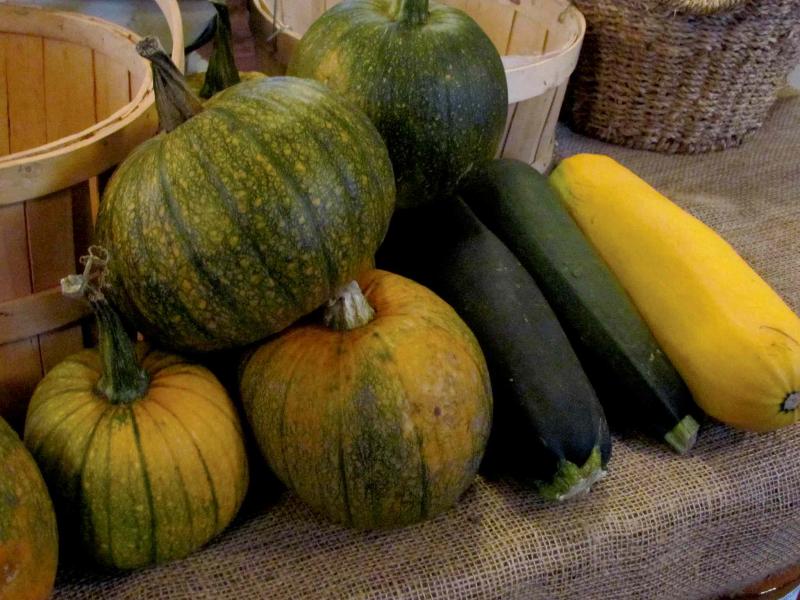2
After reaping a record bumper crop last year, Buckmaster says 2014's short, unpredictable and very wet growing season resulted in reduced yields for many of the vegetable crops we are used to enjoying at this time of the year.
Pumpkins are one of the locally grown crops that have been affected by the cooler growing conditions. Red River General Store sits on 0.8 hectares and only chemical-free heritage varieties are grown. Normally, it prides itself on specialty pumpkins but has smaller quantities to sell this October.
Turban-shaped, deeply ribbed Queensland blue pumpkin is one of Buckmaster's favourite. This year's yield of the warty blue pumpkin with its full-flavoured golden orange flesh pales in comparison to last year's bountiful harvest. Fairytale pumpkin, an eye-catching mahogany brown squat-shaped pumpkin similar to the Cinderella pumpkin, is still available at Red River General Store, but in limited quantities.
Other varieties such as Hopi White Jack O'lantern and deep blue-green Marina di Chioggia, a warty pumpkin, failed this year due to excess rain and hail.
Buckmaster, who firmly believes that if you can't eat it there's no point in growing it, says Marina di Chioggia's deep orange flesh is great for cooking and baking in pies. "The wartier a pumpkin," says Buckmaster, "the sweeter it is."
The ambience of Red River General Store hearkens back to a bygone era. Assorted vintage baskets brimming with luscious vegetables in dusky to bright hues are surrounded by jars of preserves, packaged organic seeds from Baker Creek Heirloom Seed Company, and vintage items including an expansive collection of old tins, stacked on wooden shelves to the ceiling.
Buckmaster and the store itself embraces visitors in a grow-local, eat-local philosophy that frankly, persuades one fairly quickly that fresh, luxurious flavour is worth the effort..
Some of that effort came as a result of a cutworm infestation which Tom Gonsalves, vegetable crop specialist for Manitoba Agriculture, Food and Rural Development, says affected many local growers.
Buckmaster swears by the method of planting by the moon and plants her ground crops such as tomatoes and green peppers by the first full moon, which this year occurred on June 13. Cutworms quickly destroyed one-half of the pepper crop and damaged the tomato crop.
Buckmaster, who does succession planting to ensure a plentiful supply throughout the growing season, applied cutworm collars, cutting out the bottoms of plastic containers, placing them over each seedling and burying the edges 2.5 cm deep. Buckmaster plans to be very diligent in removing all debris and dead plant material from her garden this fall to discourage pests from making any reappearance next spring. She is also planning to spread diatomaceous earth. Consisting of the fossilized remains of diatoms, a type of tiny algae, the sharp edges of this material cut an insect's outer skin, resulting in death.
It must be reapplied after rainfall.
Although her crop of aubergine-coloured purple beauty peppers, a favourite of Buckmaster's, were late, they were abundant. She admits the tomato crop was disappointing but is looking forward to homemade sun-dried tomatoes for use in recipes all winter long.
"The best drying tomato is Principe Borghese, an Italian heirloom," said Buckmaster. Slightly larger than a cherry tomato, Buckmaster begins by arranging the sliced tomatoes, cut side up, on a parchment lined pan. She adds herbs, and then dries the tomatoes in the oven at a low heat until the tomatoes have a crisp texture on the outside and are chewy on the inside.
Buckmaster leaves the dried tomatoes in a large jar on her kitchen counter. Once she is ready to use them, they are soaked in garlic and olive oil and rehydrated. "While I am making rice, I toss in the dried tomatoes and as the rice cooks, the tomatoes puff up, adding beautiful flavour."
Depending on the degree of dryness that is preferred, Buckmaster also crumbles dried tomatoes into a red powder, adding it to homemade soup.
She is already looking forward to the next growing season when she plans to plant a greater quantity of Paul Robeson tomatoes. With an intense, earthy flavour, this juicy variety is named for Paul Robeson, a famous stage actor and operatic singer.
For recipes such as pumpkin butter or pumpkin fruit leather or to register for fall and winter classes, visit www.redrivergeneral.com.
Although Penner Pumpkins, located near Steinbach, did not suffer crop losses due to cutworms, nearly 50 per cent of their pumpkin crop was lost to heavy rainfall and hail.
Lorissa Penner said that in spite of laying black plastic mulch at the start of the season in the hopes of warming the soil early, all of their pumpkins are late in turning orange. Next spring, they will start fully 75 per cent of their pumpkins in the greenhouse so a more robust seedling can go into the ground.
Penner suggests anyone wanting a pumpkin should stop by early. Don't be deterred by greenish-coloured outer skin. Bring your pumpkin indoors to let its thick outer skin develop into a bright orange colour.
How did other plants in the squash family fare this year? Our Farm Greenhouses, located in Portage la Prairie, is the largest grower of succulents in Manitoba and has a significant presence at the St. Norbert Farmers Market, selling a range of squash varieties and other produce. Shea Doherty, who with his mother and siblings, operates Our Farm Greenhouses, has been curing squash in their greenhouse so the outside skin hardens properly.
Squash stores well, sometimes until March. "Don't pile it up," said Doherty. "Make sure there is a slight gap between each squash. Any point where they touch results in slightly higher humidity and softening."
Although blue hubbard squash suffered this year, Doherty has an abundance of spaghetti squash, as well as butternut, buttercup, and a unique chartreuse bottle gourd known as opo squash. Cylindrical shaped and smooth skinned, somewhat like an oversized zucchini, opo squash has a mild flavour and is popular in Asian-themed dishes.
The recent mild frost only heightened the flavour of carrot, parsnip, Swiss chard and kale crops.Doherty says the flavour and quality of Brussels sprouts, that perennial staple of the Thanksgiving meal, improves after a light frost. Although that particular crop was wiped out after heavy rain in the early season, Doherty has a good supply of most everything else, including a small quantity of the sought-after Cinderella pumpkin.
More correctly known as Rouge vif d'Etampes, the Cinderella pumpkin is beloved for its signature flattened top and coach-like shape as well as its unique mahogany orange colour. Doherty says it is a drier pumpkin flesh and is excellent for pies.
Jeff and Janna Veenstra, owners of Wild Earth Farms, have been filling their clients' community-supported agricultural boxes (CSA) with carrots that are just now being harvested after being reseeded three times. For the first time, they do not have beets this year and lost half of their cantaloupes and watermelons to cutworms.
"It's been an unbelievable year," said Jeff Veenstra who also sells produce at Pineridge Hollow Farmers Market. His onions did exceptionally well as did the peppers. Veenstra only grows the smaller pie pumpkins such as baby bear and snack jack and although the crop was delayed, they were able to withstand the first frost, ripening nicely after the warm spate of weather in late September.
Veenstra will begin signing up new CSA customers starting in February. Visit www.wildearthfarms.ca for more details.
Throughout Manitoba this Thanksgiving weekend, fresh local vegetables will figure prominently in many recipes. Shoppers will visit local farmers markets to select ripe veggies at the peak of their flavour. Thanksgiving, though, is also a time of generosity.
Henry and Lorette Marion, owners of H & L Gardens, a farm located near Morris, donate most of their harvest each year to Siloam Mission, Union Gospel Mission and Winnipeg Harvest. Last year, they grew 4,500 kilograms of produce on their 2.5-acre farm and donated all but 450 kg. This year, cutworms have reduced their yield, which includes potatoes, beans, tomatoes, sweet corn and carrots.
They had to reseed their carrots and pumpkins twice and saw their tomato crop reduced from last year's high of 1,800 kgs to 450 kgs. The Marions will be out in their garden next spring, armed with plant collars.
colleenizacharias@gmail.com




